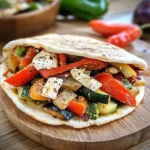This Roasted Veggie Pita recipe has become an absolute staple in our household, a true culinary chameleon that adapts to busy weeknights, lazy weekend lunches, and even impressive-looking yeteffortless offerings for guests. I first stumbled upon the idea when I had a fridge full of miscellaneous vegetables nearing their end-of-life, and a desperate need for a quick, healthy meal. The aroma that filled the kitchen as the vegetables roasted – sweet bell peppers, earthy zucchini, pungent red onion, all mingling with aromatic herbs and a touch of smoky paprika – was enough to draw everyone in. When my kids, who can sometimes be picky about vegetables, actually devoured their pitas, loading them with the colorful medley and a generous dollop of creamy tahini sauce, I knew I had a winner. It’s not just the taste, which is a symphony of sweet, savory, and tangy notes, but also the textures – the crisp-tender vegetables, the soft, warm pita, the smooth sauce – that make this dish so incredibly satisfying. It’s a recipe that proves healthy eating can be incredibly delicious and exciting, and it’s so versatile that we never get tired of it. It has truly transformed our approach to quick meals, making ‘what’s for dinner?’ a question I now answer with genuine enthusiasm.
Ingredients for Our Vibrant Roasted Veggie Pitas
Here’s what you’ll need to create this explosion of flavor and color. Each ingredient plays a crucial role in building the overall taste profile, ensuring a balanced and delicious meal.
- For the Roasted Vegetables:
- Red Bell Pepper – 1 large, cored, seeded, and roughly chopped into 1-inch pieces. Its sweetness intensifies beautifully when roasted, adding a lovely vibrant color.
- Yellow or Orange Bell Pepper – 1 large, cored, seeded, and roughly chopped into 1-inch pieces. Complements the red pepper with a slightly different sweet note and more visual appeal.
- Zucchini – 1 medium, trimmed and chopped into 1-inch pieces. Adds a mild, slightly earthy flavor and a tender texture.
- Red Onion – 1 medium, peeled and cut into 1-inch wedges. Roasting tames its sharpness, bringing out a delightful sweetness.
- Cherry or Grape Tomatoes – 1 pint, left whole or halved if large. These burst with juicy sweetness when roasted, creating little pockets of flavor.
- Chickpeas – 1 can (15 ounces), rinsed and thoroughly drained. These add a fantastic source of plant-based protein and a satisfying, slightly firm texture. Ensure they are very dry before roasting for best results.
- Extra Virgin Olive Oil – 3 to 4 tablespoons. The heart of Mediterranean cooking, it helps the vegetables caramelize and carries the flavors of the spices.
- Dried Oregano – 1 ½ teaspoons. A classic Mediterranean herb that pairs wonderfully with roasted vegetables.
- Smoked Paprika – 1 teaspoon. Lends a subtle, delicious smoky depth that elevates the entire dish.
- Garlic Powder – ¾ teaspoon. Adds a savory, aromatic kick without the risk of burning fresh garlic.
- Sea Salt – ¾ teaspoon, or to taste. Enhances all the other flavors.
- Freshly Ground Black Pepper – ½ teaspoon, or to taste. Provides a gentle warmth.
- For the Tahini Sauce:
- Tahini (Sesame Paste) – ½ cup. Look for a good quality, runny tahini for the best sauce. It’s the creamy, nutty base.
- Fresh Lemon Juice – ¼ cup (from 1-2 lemons). Adds essential brightness and acidity to cut through the richness of the tahini.
- Garlic – 1-2 cloves, minced or grated. Provides a pungent, zesty kick. Adjust to your preference.
- Cold Water – ¼ to ½ cup. Used to thin the sauce to the desired consistency; tahini will seize up initially then become smooth.
- Sea Salt – ¼ teaspoon, or to taste. Balances the flavors.
- For Serving:
- Whole Wheat Pita Bread – 4 to 6 large rounds. Whole wheat adds extra fiber and a nuttier flavor.
- Fresh Parsley or Cilantro – ¼ cup, roughly chopped (optional, for garnish). Adds a touch of freshness and color.
- Crumbled Feta Cheese (optional) – For a salty, briny addition.
- Hot Sauce or Chili Flakes (optional) – For those who like an extra kick of heat.
Step-by-Step Instructions for Perfect Roasted Veggie Pitas
Follow these simple steps to create a meal that’s as enjoyable to make as it is to eat. The process is straightforward, relying on the oven to do most of the heavy lifting.
- Preheat and Prepare: Preheat your oven to 400°F (200°C). Line a large, rimmed baking sheet with parchment paper for easy cleanup. If you don’t have a large enough baking sheet, use two to avoid overcrowding the vegetables, which can cause them to steam rather than roast.
- Combine Vegetables and Seasonings: In a large mixing bowl, combine the chopped red bell pepper, yellow/orange bell pepper, zucchini, red onion wedges, and cherry tomatoes. Add the rinsed and thoroughly dried chickpeas to the bowl.
- Dress the Vegetables: Drizzle the vegetables and chickpeas generously with the extra virgin olive oil. Sprinkle over the dried oregano, smoked paprika, garlic powder, sea salt, and freshly ground black pepper. Use your hands or a large spoon to toss everything together until the vegetables and chickpeas are evenly coated with the oil and spices. This step is crucial for ensuring every bite is flavorful.
- Roast the Vegetables: Spread the seasoned vegetable and chickpea mixture in a single layer on the prepared baking sheet(s). It’s important not to overcrowd the pan, as this allows the hot air to circulate around each piece, promoting caramelization and browning rather than steaming.
- Roasting Time: Place the baking sheet in the preheated oven and roast for 25-35 minutes. About halfway through the roasting time (around 15 minutes), toss or stir the vegetables to ensure even cooking and browning on all sides. The vegetables are done when they are tender, slightly charred at the edges, and the tomatoes have begun to burst. The chickpeas should be slightly crisped.
- Prepare the Tahini Sauce: While the vegetables are roasting, prepare the tahini sauce. In a medium bowl, whisk together the tahini and fresh lemon juice. The mixture will thicken considerably and may look seized or clumpy – this is normal.
- Emulsify the Sauce: Gradually add the cold water, one tablespoon at a time, whisking continuously until the sauce becomes smooth, creamy, and reaches your desired drizzling consistency. You might need more or less water depending on your tahini.
- Season the Sauce: Stir in the minced garlic and sea salt. Taste and adjust seasoning if necessary – you might want more lemon juice for tanginess or a pinch more salt. Set aside.
- Warm the Pitas: A few minutes before the vegetables are done roasting, warm the pita bread. You can do this by wrapping them in foil and placing them in the oven for the last 5 minutes of roasting, toasting them lightly in a toaster, or warming them for a few seconds on each side in a dry skillet over medium heat. Warm pitas are softer and more pliable.
- Assemble the Pitas: Once the vegetables are perfectly roasted and fragrant, and the pitas are warm, it’s time to assemble. Carefully open each pita pocket (or serve them flat and let everyone build their own).
- Fill and Serve: Generously fill each pita with a hearty portion of the roasted vegetables and chickpeas. Drizzle liberally with the prepared tahini sauce. Garnish with fresh chopped parsley or cilantro, and a sprinkle of feta cheese or chili flakes if desired. Serve immediately and enjoy the delicious fusion of flavors and textures.
Nutrition Facts: A Healthy & Hearty Meal
This Roasted Veggie Pita recipe is not only delicious but also packed with nutrients.
- Servings: This recipe makes approximately 4 generous servings.
- Calories per serving: Approximately 450-550 calories (this can vary based on pita size, exact amount of oil, and optional additions like feta).
- Fiber: High in dietary fiber (approx. 10-15g per serving) primarily from the whole wheat pitas, vegetables (especially chickpeas and bell peppers), which aids digestion, promotes satiety, and helps regulate blood sugar levels.
- Protein: A good source of plant-based protein (approx. 15-20g per serving), mainly from the chickpeas and tahini, essential for muscle repair, immune function, and overall body maintenance.
- Healthy Fats: Contains beneficial monounsaturated and polyunsaturated fats (from olive oil and tahini), which are important for heart health, brain function, and nutrient absorption.
- Vitamins & Minerals: Rich in various vitamins and minerals, including Vitamin C (from bell peppers and tomatoes), Vitamin A (from bell peppers), iron (from chickpeas and tahini), and B vitamins, all crucial for energy production and overall well-being.
- Low Saturated Fat: Naturally low in saturated fat, making it a heart-healthy meal choice.
Preparation Time: Quick & Easy
This recipe is designed for efficiency without compromising on flavor.
- Chopping & Prep Time: Approximately 15-20 minutes. This involves washing and chopping the vegetables, and rinsing the chickpeas. Investing in a good sharp knife can make this process even quicker.
- Roasting Time: Approximately 25-35 minutes. During this time, you can prepare the tahini sauce and tidy up, making it an active cooking time of only a few minutes.
- Total Time: Approximately 40-55 minutes from start to finish. This makes it an excellent option for a weeknight dinner that feels special but doesn’t require hours in the kitchen. The hands-off roasting time is a huge bonus for busy schedules.
How to Serve Your Delicious Roasted Veggie Pitas
There are many wonderful ways to present and enjoy these flavorful pitas, catering to different preferences and occasions.
- Classic Pocket Style:
- Gently warm the pita breads until soft and pliable.
- Carefully cut one edge or the top half of the pita to create a pocket.
- Stuff the pocket generously with the warm roasted vegetables and chickpeas.
- Drizzle lavishly with the creamy tahini sauce.
- Garnish with fresh herbs like parsley or cilantro.
- Serve immediately for the best texture contrast between the warm filling and soft pita.
- Deconstructed or Family Style:
- Arrange the warm pita breads (whole or cut into wedges) on a platter.
- Serve the roasted vegetables in a large bowl.
- Place the tahini sauce in a separate small bowl with a serving spoon.
- Offer small bowls of optional toppings like crumbled feta, chopped olives, extra herbs, or a lemon wedge.
- This allows everyone to build their own pita to their liking, which is especially great for families with different preferences or for casual gatherings.
- Open-Faced Pitas:
- Lightly toast the pita bread until slightly crisp.
- Lay the pita flat on a plate.
- Pile the roasted vegetables and chickpeas on top.
- Drizzle with tahini sauce and add garnishes.
- This version is often eaten with a knife and fork.
- As Part of a Mezze Platter:
- Serve smaller portions of the roasted vegetables alongside other Mediterranean dips like hummus or baba ghanoush.
- Include pita wedges for dipping.
- Add olives, marinated artichoke hearts, and cucumber slices to complete the spread.
- With a Side Salad:
- For a fuller meal, serve the stuffed pitas with a simple side salad, such as a Greek salad (cucumber, tomato, olives, feta) or a light green salad with a lemon vinaigrette.
- Lunchbox Friendly (with a trick):
- Pack the roasted vegetables and tahini sauce in separate containers.
- Include a whole pita bread.
- Assemble just before eating to prevent the pita from becoming soggy. The veggies are also delicious cold or at room temperature.
Additional Tips for Roasted Veggie Pita Perfection
Elevate your roasted veggie pita game with these handy tips and tricks.
- Don’t Overcrowd the Pan: This is crucial for achieving perfectly roasted, caramelized vegetables rather than steamed ones. If necessary, use two baking sheets. Give your veggies space to breathe and brown.
- Uniform Chopping for Even Cooking: Try to chop your vegetables into roughly uniform sizes (around 1-inch pieces). This ensures they cook at a similar rate, so you don’t end up with some bits burnt and others undercooked.
- High Heat is Your Friend: Roasting at a higher temperature like 400°F (200°C) helps to achieve that desirable browning and slight charring, which brings out the natural sweetness of the vegetables.
- Dry Your Chickpeas Thoroughly: After rinsing canned chickpeas, pat them very dry with paper towels or a clean kitchen towel. Excess moisture will prevent them from getting slightly crispy during roasting.
- Spice it Up or Down: Feel free to adjust the spices to your liking. Add a pinch of red pepper flakes for heat, a bit of cumin for earthiness, or even some sumac for a lemony tang. Fresh herbs like rosemary or thyme can also be added to the roasting pan.
- Tahini Sauce Consistency: The consistency of tahini can vary greatly by brand. If your sauce is too thick, add more cold water, a teaspoon at a time. If it’s too thin, you can try adding a tiny bit more tahini, but be cautious as it can easily become too thick again. The key is to add water slowly and whisk well.
- Make-Ahead Components: You can roast the vegetables ahead of time and store them in an airtight container in the refrigerator for up to 3-4 days. The tahini sauce can also be made in advance and stored for up to a week (it may thicken, so you might need to whisk in a little more water before serving). Reheat veggies gently before assembling.
- Pita Preparation Matters: Warm pitas are much more enjoyable – they become softer and more pliable. Whether you warm them in the oven, toaster, or a dry skillet, don’t skip this step. For an extra touch, lightly brush them with olive oil before warming.
Frequently Asked Questions (FAQ) about Roasted Veggie Pitas
Here are answers to some common questions you might have about this recipe.
- Can I use different vegetables?
Absolutely! This recipe is incredibly versatile. Feel free to substitute or add other vegetables like broccoli florets, cauliflower florets, mushrooms, sweet potatoes (dice smaller as they take longer to cook), carrots, or eggplant. Adjust roasting time as needed. - Is this recipe vegan?
Yes, as written, this recipe is fully vegan. Ensure your pita bread is vegan (most are, but always check the label if concerned) and omit any optional non-vegan additions like feta cheese. - How do I make this gluten-free?
Simply use your favorite gluten-free pita bread or gluten-free wraps. The roasted vegetables and tahini sauce are naturally gluten-free. You could also serve the roasted veggie mixture over quinoa or rice. - How long can I store leftovers?
It’s best to store the roasted vegetables and tahini sauce separately in airtight containers in the refrigerator. The vegetables will keep for 3-4 days, and the tahini sauce for up to a week. Assemble the pitas just before serving to prevent them from getting soggy. - How should I reheat the leftovers?
Reheat the roasted vegetables in a skillet over medium heat, in the oven at 350°F (175°C) for 10-15 minutes, or in the microwave until warmed through. The tahini sauce is best served chilled or at room temperature; you may need to whisk in a bit of water if it has thickened. Warm your pitas separately. - Can I use frozen vegetables?
While fresh vegetables will yield the best texture and flavor, you can use frozen vegetables in a pinch. Thaw them and pat them very dry before roasting to remove excess moisture. They may not caramelize as well and might require a slightly adjusted roasting time. - My tahini sauce seized up and became very thick. What did I do wrong?
This is completely normal! When you first mix tahini with lemon juice (or any acidic liquid), it will seize and thicken dramatically. Keep adding cold water, a little at a time, and whisking vigorously. It will eventually loosen up and become smooth and creamy. - What other sauces could I use if I don’t have tahini?
While tahini sauce is classic, you could also use hummus (store-bought or homemade), a simple Greek yogurt sauce (tzatziki-style with cucumber, garlic, and dill – if not vegan), or even a dairy-free yogurt alternative mixed with herbs and lemon. A balsamic glaze could also add a nice touch.






